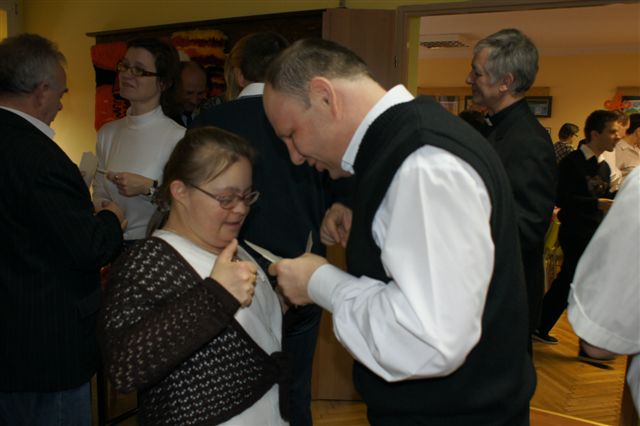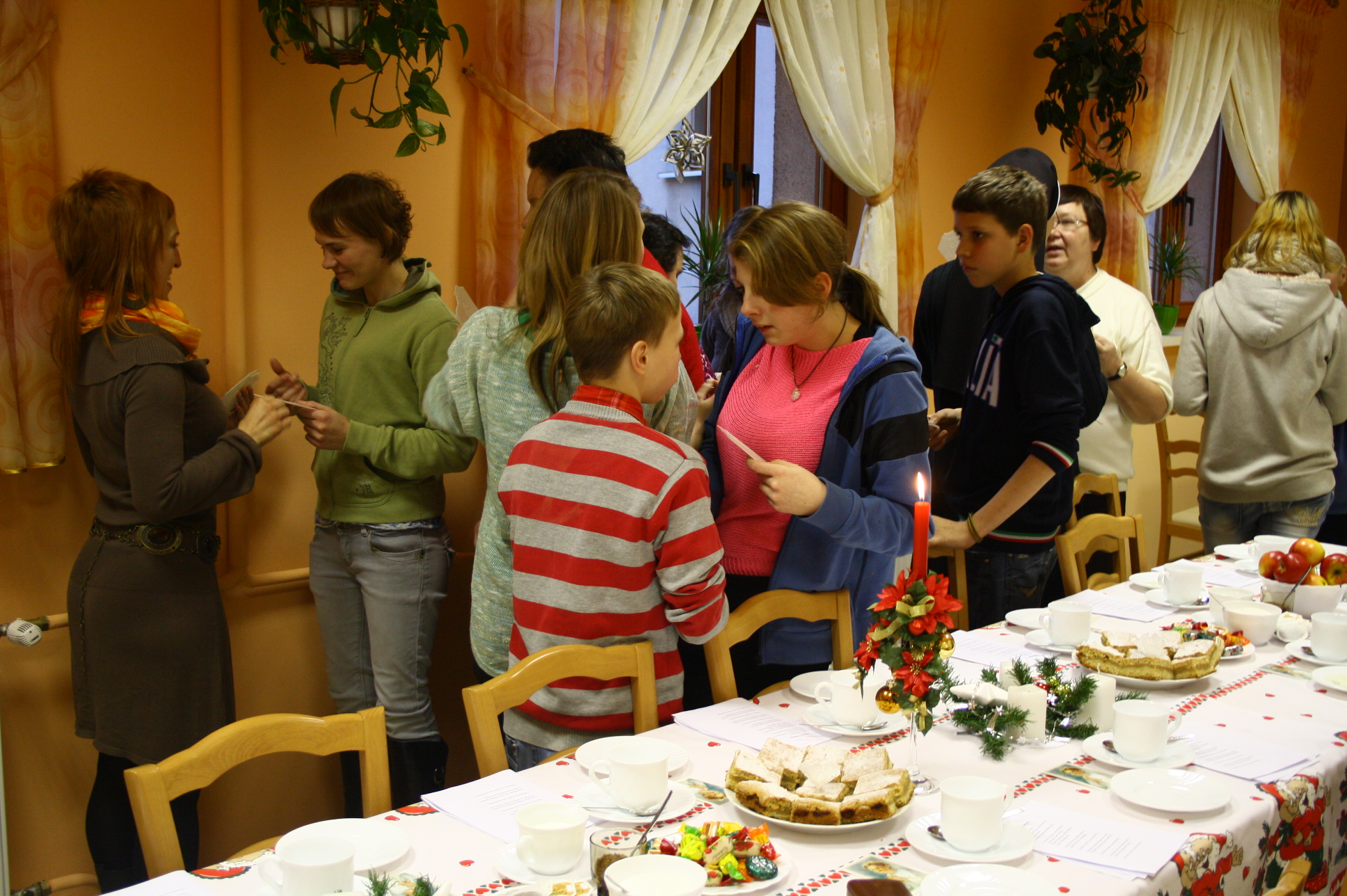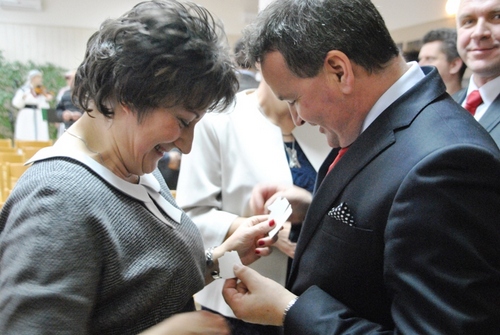Post by Bonobo on Dec 24, 2016 22:07:38 GMT 1
Unique tradition
Wiki
Christmas wafer (Polish: opłatek, plural opłatki; Lithuanian: kalėdaitis, plural kalėdaičiai) is a central European Christian Christmas tradition celebrated in Poland, Lithuania and in some parts of Slovakia during Wigilia, or the Christmas Eve Vigil.[1]
The unleavened wafers are baked from pure wheat flour and water, are usually rectangular in shape[2] and very thin; they are identical in composition to the altar bread that becomes the Eucharist at the consecration during Mass in the Roman Catholic Church. Being only a reminder of the Body of Christ used in private homes, Opłatki lack sanctification by a priest or bishop. The Opłatki wafers are embossed with Christmas-related religious images, varying from the nativity scene, especially Virgin Mary with baby Jesus, to the Star of Bethlehem.
Before partaking of the Christmas Eve meal, the family gathers around the table. The eldest member holds a large wafer and breaks off a piece to begin the ritual.[3]The remaining wafer is passed on to another member while a prayer for loved ones is said. This continues until everyone at the table has a piece of the wafer. Finally, the family members consume their share quietly.[4]
History and Cultural Importance
The breaking of the Christmas wafer is a custom that began in Poland in the 10th century and is practiced by people of Polish ancestry around the world. It is considered the most ancient and beloved of Polish traditions.[5]
The tradition traces its origins to the times of early Christianity (see Antidoron) and is seen as a non-sacramental foreshadowing of the liturgical partaking of the Holy Eucharist (Host), unleavened bread consecrated into the Body, Blood, Soul and Divinity of Jesus Christ. As a Christmas custom the “opłatek” originated in Poland and was spread widely as far back as the 17th century. It was the part of the szlachta's (Polish nobility) culture and the custom had spread throughout the Polish-Lithuanian Commonwealth and neighbouring countries. In the 19th century in the aftermath of the partitions of Poland it gained patriotic subtexts as the common wish during sharing of “opłatek” became the wish for Poland's regaining its independence. Since that time “opłatki” are often embossed with religious images. In the 20th century “opłatek” custom went beyond families and gained another meaning: the meeting of present or past co-workers or students.
In Poland and some parts of Central Europe, these Christmas wafers are dyed and used as ornaments.[6] They are also sent as small trinkets with greeting cards to loved ones who are away from home.[7]
The Christmas wafer symbolizes the unity of the family,[8] which many consider to be the main pillar of society. According to beliefs, the bond of unity should exist between family members. The father is seen as the link in the unbroken chain of One Body, One Bread, One Christ, and One Church, while other family members join him in this eternal procession. The wafer also symbolizes forgiveness and reconciliation.










Wiki
Christmas wafer (Polish: opłatek, plural opłatki; Lithuanian: kalėdaitis, plural kalėdaičiai) is a central European Christian Christmas tradition celebrated in Poland, Lithuania and in some parts of Slovakia during Wigilia, or the Christmas Eve Vigil.[1]
The unleavened wafers are baked from pure wheat flour and water, are usually rectangular in shape[2] and very thin; they are identical in composition to the altar bread that becomes the Eucharist at the consecration during Mass in the Roman Catholic Church. Being only a reminder of the Body of Christ used in private homes, Opłatki lack sanctification by a priest or bishop. The Opłatki wafers are embossed with Christmas-related religious images, varying from the nativity scene, especially Virgin Mary with baby Jesus, to the Star of Bethlehem.
Before partaking of the Christmas Eve meal, the family gathers around the table. The eldest member holds a large wafer and breaks off a piece to begin the ritual.[3]The remaining wafer is passed on to another member while a prayer for loved ones is said. This continues until everyone at the table has a piece of the wafer. Finally, the family members consume their share quietly.[4]
History and Cultural Importance
The breaking of the Christmas wafer is a custom that began in Poland in the 10th century and is practiced by people of Polish ancestry around the world. It is considered the most ancient and beloved of Polish traditions.[5]
The tradition traces its origins to the times of early Christianity (see Antidoron) and is seen as a non-sacramental foreshadowing of the liturgical partaking of the Holy Eucharist (Host), unleavened bread consecrated into the Body, Blood, Soul and Divinity of Jesus Christ. As a Christmas custom the “opłatek” originated in Poland and was spread widely as far back as the 17th century. It was the part of the szlachta's (Polish nobility) culture and the custom had spread throughout the Polish-Lithuanian Commonwealth and neighbouring countries. In the 19th century in the aftermath of the partitions of Poland it gained patriotic subtexts as the common wish during sharing of “opłatek” became the wish for Poland's regaining its independence. Since that time “opłatki” are often embossed with religious images. In the 20th century “opłatek” custom went beyond families and gained another meaning: the meeting of present or past co-workers or students.
In Poland and some parts of Central Europe, these Christmas wafers are dyed and used as ornaments.[6] They are also sent as small trinkets with greeting cards to loved ones who are away from home.[7]
The Christmas wafer symbolizes the unity of the family,[8] which many consider to be the main pillar of society. According to beliefs, the bond of unity should exist between family members. The father is seen as the link in the unbroken chain of One Body, One Bread, One Christ, and One Church, while other family members join him in this eternal procession. The wafer also symbolizes forgiveness and reconciliation.





















